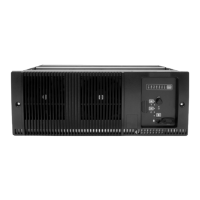TB9100 Reciter Service Manual Power Supply 101
© Tait Electronics Limited January 2006
7 Power Supply
The reciter is designed to operate from the +28V regulated supply provided
by the PMU. The nominal +28V supply enters the reciter digital PCB and
passes through an overcurrent and overvoltage protection section before
being distributed. The protected +28V output supplies the control
comparators, fan switch, and main regulators. There is one regulator on the
digital PCB and another on the RF PCB.
7.1 RF PCB
The main regulator is a switched mode converter that has two outputs: the
flyback portion generates +8.5V, and the buck portion generates +5.3V.
The +8.5V supply is regulated to +8.0V for reticulation to the RF circuits,
either directly, or via switching circuits used in power saving modes.
The +8.5V supply is also used to power the analog sections of the network
PCB (via the digital PCB).
The +5.3V supply is regulated to +3.3V to power the RF synthesizers.
The RF PCB has a charge pump converter that generates +23V from both
the +5.3V and +8.5V supplies. This is used to supply the active loop filters
of the RF synthesizers. The +8.5V output and the +5.3V supply to the
charge pump can be switched as part of the power saving modes.
7.2 Digital PCB
The main regulator is a switched mode converter that has two outputs: the
flyback portion generates +5.3V, and the buck portion generates +3.3V.
The +5.3V output supplies the op amps associated with the CODECs and
is distributed with regulators: +5V for the ADC, +5V for the system, and
+3V for the 40MHz clock circuitry. The +5.3V and +5V regulated
supplies can be switched as part of the power saving modes.
The +3.3V output is distributed to the remaining circuitry and to the
+2.5V regulator for the DSP. These are switched as part of the power saving
modes. The +3.3V output is also supplied to the network PCB via a
protection circuit.

